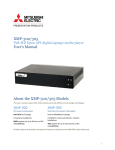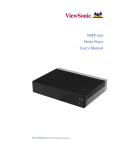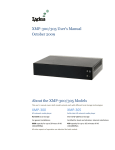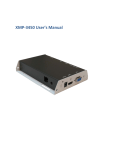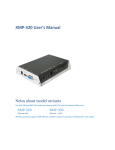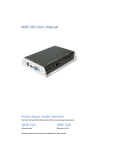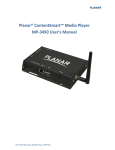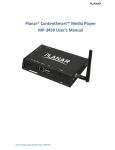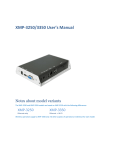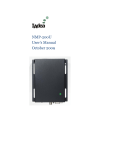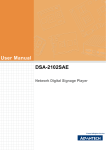Download Mitsubishi HMP-500S User`s manual
Transcript
HMP-500S/505S Media Player User’s Manual About the HMP-500S/505S Models This user’s manual applies to both model variants each with different local storage technologies: HMP‐500S HMP‐505S HD network media player Solid‐state HD network media player Hard disk local storage Internal CF card local storage For general installations Certified for shock and vibration‐ tolerant installations 80GB capacity for up to 30 hours of HD video@8Mbps 4GB capacity for up to 105 minutes of HD video@8Mbps All aspects of operation for the HMP‐505S are identical to the HMP‐500S model as depicted in the illustrations. © 2009 Mitsubishi Digital Electronics America www.mitsubishi‐presentations.com/ Contents 1. Introduction to the HMP‐500S/505S Media Player ........................................... 1 1.1. Software Management Features ........................................................................................................................................... 1 1.2. Package Contents .................................................................................................................................................................. 1 1.3. Physical views ........................................................................................................................................................................ 1 1.4. Unit Installation ..................................................................................................................................................................... 2 2. Player System Setup........................................................................................... 2 2.1. Setting up the Player ............................................................................................................................................................. 2 2.2. Setting up Adfotain Manager Express ................................................................................................................................... 3 2.3. Configuration with Adfotain Manager Express...................................................................................................................... 4 3. Content Management with Adfotain Manager Express .................................... 7 4. Specifications table ............................................................................................ 7 5. Appendix: FAQ.................................................................................................... 8 6. Appendix: Alternative Network Configuration Method..................................... 9 6.1. Using a Web Browser for Network Configuration ................................................................................................................. 9 6.2. Logging in to the HMP‐500S/505S......................................................................................................................................... 9 6.3. Additional device settings table........................................................................................................................................... 11 7. Appendix: Firmware Upgrades......................................................................... 12 7.1. Firmware upgrade using Adfotain Manager Express........................................................................................................... 12 1. Introduction to the HMP‐500S/505S Media Player The HMP‐500S/505S Media Player is an industrial‐grade, network managed, high‐definition media player suitable for large format digital signage displays such as LCDs and projectors. • • • • • • • Feature‐rich high‐definition Managed through internet Includes turn‐key Microsoft Windows‐based Adfotain Manager tool for simplified scheduling and screen layout management Support multiple screen partitions Uninterrupted playback during file update Low power consumption fanless design 4GB Internal SLC high‐performance solid‐state storage (HMP‐505S only) 1.1. Software Management Features Adfotain Manager Express digital signage software included Adfotain Manager signage player. Featuring to deliver dynamic HD‐ audience. For details on see the Adfotain Manager Express lets you quickly schedule and playback program on your digital an intuitive visual calendar layout, this bundled PC application makes it easy quality videos, photos, and PowerPoint slides (stills) to your intended management features such as day‐parting and content distribution, please Express Software User's Manual. Automatic network detection and onetomany network transfer Once you have scheduled with a few clicks of the simultaneously updated your contents, you can quickly send it out to your players across the network mouse. All players on the same network are automatically located and within Adfotain Manager Express, saving precious time. Disruption–free content update via USB To manage the HMP‐ to sync your contents. connect the device to the disruption to your current USB UPDATE 1.2. Package 500S/505S Media Player over a network, you can use a USB mass‐storage device Simply export the new playlist and media files to a removable storage device and player to initiate automatic update. The player can update contents without any playback. Contents Media Player Unit AC Adapter and Cord Mounting Plate (x2) Screw (x4, not shown) Ethernet cable RCA to 1/8” mini‐jack audio adapter 1/8” to 1/8” mini‐jack audio cable Software CD Quick Start Guide 1.3. Physical views © 2009 Mitsubishi Digital Electronics America www.mitsubishi‐presentations.com/ 1.4. Unit Installation The HMP‐500S/505S is supplied with a pair of mounting plates for unit installation. 1. Attach the mounting plates to the bottom side of the player with 2 screws (supplied) on each side. Supplied Mounting Plates (x2) 2. The player with the mounting plates attached can be mounted using 4 screws (not supplied) at 76mm X 228mm (2.99” X 8.98”) spacing. 2. Player System Setup 2.1. Setting up the Player Attach a video cable (DVI, video, Svideo, or VGA) to your display Connect and power on your display. Switch your display to the corresponding video input mode (VGA /Video/S‐ video/DVI/HDMI) • • • If your display lacks DVI or HDMI and requires a VGA connection, a DVI to VGA is required. If your display has HDMI but not DVI, you can purchase an HDMI‐DVI adapter or cable. For audio output, connect the supplied stereo RCA cable from the player to your monitor. Connect player to your network Connect player to your network router. Adfotain Manager Express can detect the IP location of your player automatically on a DHCP network. See setting up Adfotain Manager Express in this section to set up the program on your PC. *If your network requires a static IP, you can also use Adfotain Manager Express to set up the static IP. Please contact your network administrator if you are unsure which IP addresses are available on your network. Network router Attach the AC power adapter to power on the unit Æ green power indicator on adapter Æ green power indicator on front Connect the Power Adapter to a wall outlet and player. The Æ green power indicator on the player unit will immediately light up. The player should display on screen information on your screen corners during boot up. Wait a few moments to let the process complete. 2.2. Setting up Adfotain Manager Express Adfotain Manager Express lets you perform player configuration, maintenance, and scheduling operations from your PC. Installation Minimum system requirements Windows Vista or Windows XP operating systems 1 GHz AMD or Intel CPU .DirectX 9 512 MB of system memory .NET Framework 3.0 (higher versions and numbers also compatible) PowerPoint 2003 or 2007 required for PowerPoint slideshow feature. Windows Media Player 10 or 11 required for video previews. Setup process Insert the Adfotain Manager Express CD and the installer should pop up automatically. If it does not start, click on “setup.exe” located on your CD using Windows Explorer. If you haven’t installed .NET Framework, you will be prompted to do so. If it is already installed, please 20 GB hard drive For Windows XP only: .Net Installation The Windows .NET Framework is included on the CD and will be installed if absent from your system. Click Yes and follow the prompts to install it © 2009 Mitsubishi Digital Electronics America www.mitsubishi‐presentations.com/ proceed to the next section. 1. 2. Run the installer and follow the step by step instructions. Close the installer to finish installation. 2.3. Configuration with Adfotain Manager Express Setting the clock 1. Start Adfotain Manager Express and select player model 2. 3. After selecting the player, click on the Configuration button on the top right. Click Auto‐detect player button to locate all network‐connected devices of the same model. A progress bar is shown, and players are added to a list of operational network devices. You can also stop the search once the target device appears in the list. Green z : player is online 4. 5. Red z : previously detected but currently offline Check the box preceding each target player and click Modify settings. You can configure more than one player at once. In the General Settings tab, confirm and select the appropriate time zone to ensure correct schedule playback. The time and date is automatically synchronized with your PC when you click Apply. Some options may not be available depending on your player mod 6. Set the device password. The device password protects contents from begin updated by unauthorized sources. You can either remove the password (check “Reset password to blank”) or specify a new password for the player(s). Setting the network identification If you are using a DHCP network, please proceed to the next section. © 2009 Mitsubishi Digital Electronics America www.mitsubishi‐presentations.com/ The network settings tab lets you specify the player‘s static IP address and other settings. It’s important that no two devices on the network share the same IP. Net mask, gateway, domain, and DNS can also be configured on this page. Please consult your network administrator if you are uncertain of the values to these settings. Advanced settings This page lets you change the management mode of the device. 1. 2. 3. LAN mode (default): This allows local network management via Adfotain Manager Express. USB mode: This mode limits player content updates via USB drive or CF card only. WAN mode: Reserved Content Management with Adfotain Manager Express Please see Adfotain Manager Express 2.0 User’s Manual for content management operation. 3. Specifications table HMP‐500S HMP‐505S Video format support POPAI Screen Media Standards S6 (MPEG‐1 SIF, 3Mbps CBR) S7 (MPEG‐1 480p, 10Mbps CBR) S8 (MPEG‐1 720p, 15Mbps CBR) S9 (MPEG‐2 480p, 6Mbps CBR) S10 (MPEG‐2 720p, 12Mbps CBR) E4 (VC‐1/WMV9, MP@ML, 720p) E7 (MPEG‐4 ASP, 480p, 10Mbps CBR) Image format support POPAI Screen Media Standards S1 (JPEG 480p baseline) S2 (JPEG 720p baseline) E1 (PNG 24bpp+alpha, 480p) E2 (PNG 24bpp+alpha, 720p) Audio codec support POPAI Screen Media Standards S4 (MPEG L2 audio) S5 (MP3 audio, 384Kbps) Playback control Alphabetical looping Adfotain playlist Content management method LAN – Adfotain® Manager Express USB direct update Physical I/O connectors DVI‐I VGA (with DVI‐to‐VGA adapter) S‐Video, composite RCA audio L/R Ethernet copper 10/100 BASE‐T USB x 2 Local storage Internal 80GB 2.5” HDD (Holds up to 36 hrs of typical 5 Mbps HD video) Accessories DVI‐to‐VGA adapter RCA male‐3.5mm female audio cable 3.5mm male‐male audio cable Ethernet cable Wall‐mount bracket VESA mounting kit (Optional) Power requirement 12V, 2A DC Power consumption Typical* 7W Environmental Operating temperature: 0 to 40° C Humidity: 5 – 85% @ 40° C Dimensions 211x153x 43 (mm) (excluding projections) 8.3 X 6 X 1.7 (inches) (excluding projections) 4GB SLC High Performance CF card (Holds up to 1.8 hrs of typical 5 Mbps HD video) Typical* 5W © 2009 Mitsubishi Digital Electronics America www.mitsubishi‐presentations.com/ Weight 1.4kg 3 lbs. 1.14kg 2.5lbs Safety UL‐approved AC adapters Certifications CE/FCC RoHS Warranty One‐year limited parts & labor 4. Appendix: FAQ For more frequently asked questions and solutions, search the online product knowledge base at www.IAdea.com/support . What can I do to improve Adfotain Manager Express performance on my PC? The latest Microsoft .NET 3.5 SP1 offers improved performance and bug fixes to Adfotain Manager Express. You can install the update via this internet browser link http://go.microsoft.com/fwlink/?LinkId=124150 or by searching for “.NET 3.5 SP1” At www.microsoft.com. What is maximum file size for a single video file? The maximum video file size for the HMP‐500S/505S Media Player is 2GB. We recommend reserving a safety margin to avoid exceeding the limit (i.e. limiting files to 1850MB). How to restore device back to factory defaults? If you forgot the password or modified settings incorrectly, follow these steps to reset player: 1. 2. 3. 4. 5. Connect a USB drive to your PC and format it using FAT or FAT32 file system Inside the USB drive, create a text file at the root level (not inside a folder) Open the file in Text Editor and type in: reset_factory_default='yes' Save the file as HMP.conf Plug USB drive created in step 3 to the HMP‐500S/505S Media Player to initiate restore How do I manage playback of my contents? Playback on a schedule is one of the main functions of your HMP‐500S/505S Media Player. It is managed via the easy to use Adfotain Manager Express software. Unlike the difficulty of programming our VCRs from a remote control, the Adfotain Manager Express software is designed to be simple by leveraging the power of your personal computer. Anyone with basic computer skills can quickly create or modify schedules, delivering the right message to the right audience at the right times. Please refer to the Adfotain Manager Express User’s Manual for detailed operations and techniques. Could the player display Flash or Microsoft PowerPoint presentations? The player features limited PowerPoint support, but not Flash support. While PCs can play many formats with varying degrees of success, RISC‐based media players are designed to play a limited number of high quality video formats (Please see spec for details). While Microsoft PowerPoint native files could not play directly on a RISC‐based player, the file is converted thru other software (i.e. Adfotain Manager Express) into an image format to be played as an image slideshow. Why won’t some media files play smoothly? The video data bit‐rate may be higher than the recommended bit rate. The video data bit‐rate is the amount of video or audio data used per second to store or play the contents, usually expressed in Mbps (mega‐bits per second). Video encoded with excessive bit‐rates will not playback smoothly in the media player, likely due to storage i/o bottlenecks. You can try recompressing unplayable video files at lower bit rates using the free and open source Handbrake tool at http://handbrake.fr/. Once you have found the right output settings for size and quality, save them in Handbrake profiles for future use. Then you can easily recompress any unplayable files you encounter in the future. Why won’t some media files play at all? Even though the player conforms to leading industry standard video formats, sometimes the videos you acquire may fall outside the compatibility matrix. If the files can play on your PC but not on your player, you should recompress the file to ensure playback. For greatest compatibility, we recommend outputting high definition content to the WMVHD format (8Mbps bit‐rate). You can recompress unplayable video files with recommended file formats and bit rates using the free and open source Handbrake tool at http://handbrake.fr/. Once you have found the right output settings for size and quality, save them in Handbrake profiles for future use. Then you can easily recompress any unplayable files you encounter in the future. The media playback looks different on a PC compared to the media player’s screen. (Wrong aspect ratio) There are 2 major aspect ratios (width‐to‐height ratios) for video content, but many kinds of displays. If you play 4:3 video on a 16:9 display (or vice versa), a circle becomes oval, and the picture takes on a squeezed or stretched look. To avoid this distorted look, adding black bars are a common technique. The HMP‐500S/505S can be configured to automatically add black bars for certain types of displays. You can set the output resolution in HMP‐500’s browser configuration page to match the native resolution of your display. Some JPEG images cannot be played in the media player. Progressive JPEG are not supported. Please convert to baseline JPEG for compatibility. JPEG images can be either of 2 types: baseline or progressive compression. Baseline JPEG offers greatest compatibility, while progressive JPEGs are suitable for web site images. Progressive images are downloaded and displayed “progressively,” being rendered more clearly as more data is received over the internet. Dedicated devices using local storage are usually incompatible with the latter type. Make sure to save images as baseline JPEG in your photo editor, or resave them as baseline JPEGs using free tools such as Paint.net (http://www.paint.net/). Does my media player support video streaming? No, all media files are designed to play from local storage (HDD or internal CF card). During content and schedule sync, contents are transferred to player’s local storage before being presented on screen. This ensures the best possible presentation and fluid delivery of your video message. Video streaming raises many playback quality issues such as image freezing, blocking, or blue‐screens, costing you valuable “air time” and losing your audience's attention. Could the media player be controlled by external input devices or interfaces? No, unless specifically developed for. Touch panel, bar code scanner, and motion sensors are popular input devices for PC based digital signage media players, but RISC based players require considerable effort to develop special hardware drivers for each I/O device. The media player is not playing. What should I do? Check the player’s messages on the display (OSD, or on screen display) for status information. Since RISC‐based media player usually lack input devices such as keyboard or mouse like PCs, troubleshooting is usually based on user’s knowledge and experience with the specific media player. First check the on screen message and stats reports. Bad play list and timing issues are two major causes of playback problems. To determine if the problem is caused by a bad play list, simply delete the play list and restart player. The player should loop through all media files, indicating a fault with the play list. If the playback is scheduled to play at specific time, check to see if the device is set to the right time zone on the world clock. When nothing seems wrong, the time zone settings may be the reason the program is not played. 5. Appendix: Alternative Network Configuration Method If your player has an older firmware, or you are unable to configure device using Adfotain Manager Express, you can configure the player using a web browser. You will also need a crossover cable to connect the player to your PC via Ethernet. 5.1. Using a Web Browser for Network Configuration The HMP‐500S/505S features a software interface, similar to a router configuration interface, to simplify the network setup process. It is compatible with standard Internet browsers such as Internet Explorer or Mozilla Firefox. Connect your player to your PC with a crossover Ethernet network cable, and type the default IP (169.254.1.1) in the browser’s address bar to log in. 5.2. Logging in to the HMP500S/505S The factory default user name is “Admin” and the password field is “digiSignage” with a capital S. (Note: If you have recently upgraded your firmware, the password field may be blank). Click on “Login” to proceed. Once logged in, you can then specify another password if necessary. If you have forgotten a previously set password, see the appendix (FAQ) for factory restore © 2009 Mitsubishi Digital Electronics America www.mitsubishi‐presentations.com/ instructions. Configure an Static IP Once you have logged in the configuration page, choose IP configuration on the left hand side: 1. 2. 3. Select Static IP Address in drop down menu as shown on image above. Fill in all fields. Contact your network administrator if you do not know the value of the fields. Click Save & Reboot to complete IP configuration. 4. Once the device has rebooted, the new IP can also be confirmed at the boot screen. Note You will no longer able to connect to your device using default IP (169.254.1.1) because the device IP has been modified to your pre‐assigned static IP. 5.3. Additional device settings table Additional configuration options in the browser menus are described in this table. Function Name Description Documentation Link to online support page (Internet access required). Online Help (www) Device Information Device Name Modify the device name. IP Configuration Automatically obtain an IP from DHCP server or assign a static IP. Extra Routing Advanced network function. Allows device to be configured under complex network environments. Please obtain the configuration data from your network administrator. Date/time setting Set your time zone and synchronize time and date of the device. Clock settings run on built‐in battery for up to several years, but initially you will need to set it to your time zone for properly scheduled playback. Video setting Choose an output resolution that matches your display’s native resolution for the best results. Security Change password Change the web browser configuration login password. Device Management (LAN mode only) File manager Add/delete media files for simple playback. For advanced scheduling features, try the Adfotain Manager Express bundled solution. View logs The playback logging feature allows you to check player activity and download data for analysis. Sample Log format: 2008/11/18‐13:11:20 play: CD99EC1F.MPG 2008/11/18‐13:14:27 play: 3D26CCA8.JPG 2008/11/18‐13:14:34 play: C7F240AD.JPG OSD Display input text/text file using OSD (on screen display) function. Maintenance Upgrade firmware Update device to latest firmware version. Backup settings Backup/restore all settings. Logout Sign out from configuration web page. © 2009 Mitsubishi Digital Electronics America www.mitsubishi‐presentations.com/ 6. Appendix: Firmware Upgrades If you are using Adfotain Manager Express to manage existing media players, you may be prompted to upgrade the firmware to ensure to enable the latest scheduling features. Current versions of the firmware update files are included on the Adfotain Manager Express CD, while future upgrades may be obtained from your reseller. 6.1. Firmware upgrade using Adfotain Manager Express 1. 2. Click “Upgrade” to enter the firmware upgrade page Select an upgrade method: Network, USB, or CF card (not all methods are available for all models). You can also manually select the location of a firmware obtained from your reseller. 3. Select your player model. If the model is not shown, then choose another applicable upgrade method to proceed. 4. If you selected USB or CF card upgrade, you will need to specify the destination path of the drive or card. If you have set a password for our player, enter it in the Password field. Related instructions will be displayed on this page to help you complete the upgrade process. Finally, click on the Update device or Prepare firmware button to begin transfer of firmware. If the firmware source file cannot be found, you will be asked to locate the firmware manually. The firmware should be available on your Adfotain Manager Express CD or via your reseller. 5.














